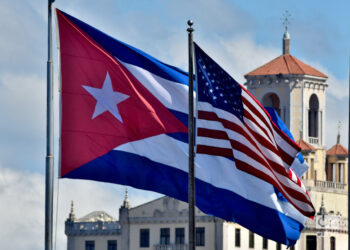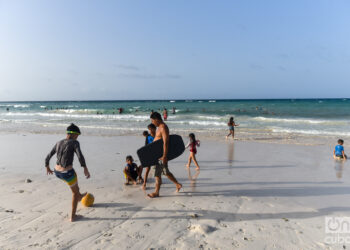In 1990, during the closing of the 5th Congress of the Federation of Cuban Women (FMC), then President Fidel Castro said: “We must be prepared for the worst circumstances…. The general principle…I want you to know that it would be, at least, that what we have we distribute among all.” There was applause in the room. In many houses, probably, it was appreciated that facing the crisis was thought of as an equal and cooperative effort.
Cuba did not implement neoliberal adjustments in that period, as many of the countries in the region had already done, which, for other reasons, were also in crisis. The scope of the market was expanded and the state apparatus was rationalized, attempts were made to attract foreign capital and create the conditions for the domestic use of the dollar and other currencies. But no public service or productive structure was privatized. The State did not lose its coordinating role. Access to work was not subordinated to the existence of a competitive labor market. Social protection circuits were maintained (universal public health and education systems, basic need food, pensions, etc.) and attempts were made to contain the widening of disadvantages and exclusions.
The crisis reached a country where poverty levels were low (6.6% in the mid-1980s) and the inequality index (Gini coefficient) was 0.24, one of the lowest in the region. Still, the socio-class structure was radically transformed. The impoverished groups swelled. In the early 2000s, urban poverty was 20%. The inequality widened.
In 2010, the country’s situation was not that of the 1990s, but there was a crisis. The government had to head a reform that would keep the national economy afloat and confront its distortions, while at the same time circumventing the intensification of the U.S. blockade against the Cuban government and people. With this driving force, the Guidelines for the Updating of the Economic and Social Model were created, debated and approved. In the process that followed, the political leadership reiterated that “in Cuba, no one will be left unprotected.” But the country had already changed. There were people, de facto, without protection. That promise of an egalitarian way out was, and is, more difficult to keep.
In 2019 the situation was worse than in 2010. The political leadership announced that, although it would not be the same as in the 1990s, “the situation could worsen…. We always have to prepare for the worst variant,” said First Secretary of the Communist Party of Cuba and former Cuban President Raúl Castro in a speech before Parliament.
In mid-2020, the COVID-19 pandemic has worsened everything. The crisis worsens in Cuba and the world. To deal with it, the government announced economic reforms that are expected to intervene for good in the distortions of the national economy. Measures or principles were taken up that had already been half stated or previously rehearsed and it is promised that they will now be implemented.
Analysis on the economic-social strategy approved by the Cuban government (I)
During his address, President Miguel Díaz-Canel Bermúdez went back to the same thesis: no one will be left unprotected. How that is to be achieve is as important as how the economic measures are to be implemented. The two questions need to be formulated and answered at the same time, not in stages, without prioritizing one over the other. It’s not possible to know if the proposed economic path is correct until it’s known what the accompanying social policy model and the program for the guarantee of rights will be.
At least four fields of that reality now need urgent attention. In this text I analyze two of them: considering the effects of the foreign exchange market for inequality and seeing to impoverished social groups or those most vulnerable to falling into poverty. In a second part, I address the remaining two: consider the inequalities that constitute the non-state sector and open the debate and economic policy to the consideration of unpaid work as work and part of the economy. I will also present a decalogue of recommendations for thinking about social inequality together with the reform package.
- Consider the effects of the foreign exchange market for inequality
The first measures implemented in mid-July were the elimination of the tax on the USD and the opening of stores in that currency. The State needs to raise foreign currency. The measure is reasonable. At the same time, it places the inequality of Cuban society in the foreground, verified in the segmentation of social groups: those who have access to USD and those who don’t.
In the first instance, the measure didn’t create inequality: those with access to freely convertible currency bought the products in an informal market with increasing levels of inflation. But in the long run it could deepen those inequalities.
The most frequent way in which people obtain foreign exchange is through remittances, the flow of which tends to be channeled through family lines.
Análisis económico: “Valdría la pena expandir las remesas digitales en la crisis económica actual”
According to the figures reported in the last National Migration Survey, 77% of the people who are living abroad temporarily or permanently send some type of aid (mainly in cash) to the members of their homes of origin in Cuba. But receiving remittances is not random; there is a pattern. The same survey confirms this.
This pattern, in emigration, is racialized. White people migrate more than black and mestizo, considering the proportion of these groups with respect to the total population. Black people, for example, are 11% of the Cuban population, but 5% of those who live abroad. On the other hand, of those who have family members abroad, 71% are white, 8% black and 22% mestizo. The same was confirmed by the results of a semi-representative national survey carried out by the German Institute of Global and Area Studies, which concludes that the current Cuban migrant community doesn’t express the racial composition of the country. In the study, of the total number of people who declared receiving remittances, 78% were white and 22% Afro-Cuban.1 Therefore, remittances in Cuba reach more white people than any other racial group.
In short, if you are a black person, you are much less likely to receive remittances and have access to the USD in this way, and more likely to be left out of the market that begins to expand with that currency. The new scenario will deepen previous inequalities, including racial ones.
Beyond racial analysis, there will be a segmentation of social groups according to the availability of a currency with which wages are not paid in the country in any of its economic sectors. Those who don’t have access to the USD will remain on the margins of that market and/or must manage their access through informal circuits for the purchase of dollars. I reiterate, those inequalities already existed, but now they could be formalized.
The situation is complex and the solution doesn’t have to be to abort the measures regarding the foreign exchange market, but what has been said needs to be considered. First of all, it’s important not to lose sight of the fact that this has to be a temporary measure and not a long-term or structural one. Your way-out map must be thought from the beginning, or generate compensation for those who don’t have or will not have access to freely convertible currency.
On the other hand, the official announcement was that the stores in freely convertible currency would sell products of medium and high ranges. But it’s essential to ensure that in the stores in CUC the basic economic products exist and the only option to acquire them is not the higher ranges, marketed in dollars to which a part of the population doesn’t have access. In this, a firm pulse is necessary, no matter the economic costs. The economic cost not assumed will imply a very high social cost, with potential consequences also for the socio-political stability of the country.
- See to impoverished social groups or those most vulnerable to falling into poverty
The winners and losers were clear from the crisis of the 1990s. Social studies show a profile of those who were most disadvantaged: women in general, single mothers, the elderly, the black and mestizo population, state workers in low-skilled jobs, impoverished territories and their migrants to more developed areas.
There are no updated official figures on poverty in Cuba. Economist Omar Everleny calculated in 2019 that around 51% of the Cuban population could be at risk of income poverty. The figure could be discussed, considering that income doesn’t come only from wages in the state sector. But the truth is that poverty has increased compared to the 1990s and inequality too.
Faced with this situation and in the midst of an aggravated crisis, it is necessary to rethink the essential social protection mechanisms so that no one is left without protection and to preserve the “spaces of equality” that still remain in Cuban society.
As part of the announcement of the new measures, the president insisted on these spaces for equality. “Here the same pounds of rice are delivered through the basic food basket to the farmers, to those who have a paladar, to those who live in the city and to those who work for the State,” he said. He was referring to the subsidized and distributed products through the food rationing policy which, during the peak of the health emergency, has also included the regulated distribution of unsubsidized products.
But transforming economic policy without doing the same with social policy can be a silly thing to do.
Sociologist Mayra Espina has identified three deficits in Cuban social policy that, despite their democratizing objectives, result in the reproduction of inequalities: deficit of economic sustainability (social expenses always above the growth of gross domestic product), diversity deficit (identification of equality with homogeneity of needs and satisfiers) and participation deficit (centralist and sectoral design of decision-making). In the midst of such an acute crisis for Cuba and the world, it’s necessary to rethink the model of social policy. It’s not necessarily virtuous to assign the same amount of rice to those who need it most and to those who don’t, if that doesn’t ensure an optimal redistribution that serves the country we really have.
The matter is being debated from different shores. Some Latin American governments are seriously exploring creating an emergency basic income to alleviate the crisis. The contraction of the global, regional and national economies is already a fact. Inequality will increase dramatically and millions of people will swell the poverty groups, which were already numerous.
To cope with this situation, contingency measures have been put in place in many countries. Previously existing Cash Transfer programs have been expanded to impoverished individuals and families, and the scope and amount of cash bonds have been expanded elsewhere. The measures are insufficient so far, because poverty was already too great and because they have been conceived for very short periods, due to the fiscal deficit of the countries and/or the neglect of the governments.
On the other hand, before this crisis, there was already a powerful criticism of targeted social assistance policies in the region, usually materialistic and disconnected from policies of access to employment and universal and free health and education services, which Cuba does have. In the midst of this scenario, social policy models are being discussed everywhere. Spain enabled a Minimum Vital Income policy that has been widely discussed. In Argentina, Mexico and Costa Rica, democratizing voices try to move this debate forward. In other regions, the relevance of a universal basic income continues to gain ground.
If Cuba is opening a potentially transformative reform of the distortions of the national economy, it’s essential to also face the discussion on the social policy model. Can we combine universalist policies with other more efficiently focused policies that support the neediest people? Can which tax policy funds will go to the non-state sector and which contributions of the state sector will go to the protection of the most disadvantaged people be defined with transparency? Can local governments have a more active and creative role in the design and implementation of social protection policies? Is it possible to rethink the model for assigning social assistance pensions and their amounts, which are currently very precarious?
While ensuring rice for all people, regardless of income, is a good holder of equal will, it doesn’t ensure that no one is left unprotected. The social policy reform is urgent.
***
Notes
- In the study, the “Afro-Cuban” category includes the black and mestizo population.










